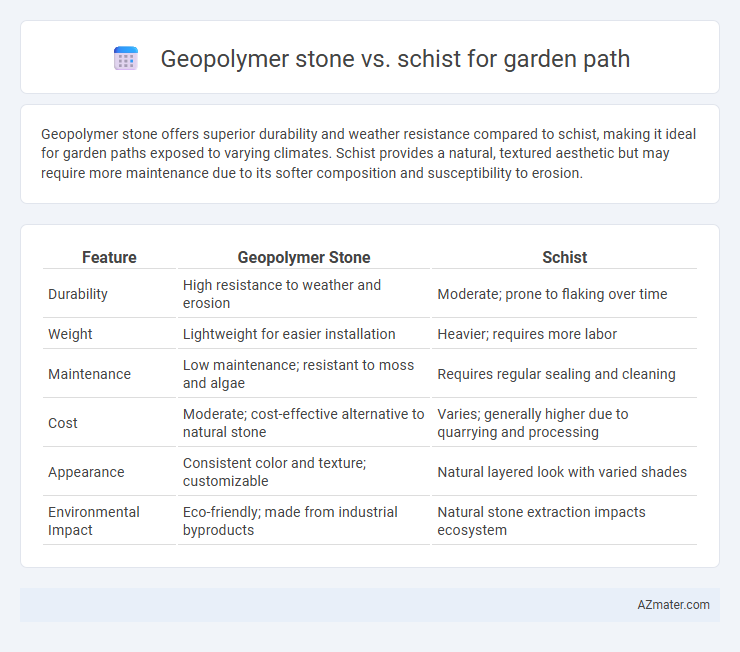Geopolymer stone offers superior durability and weather resistance compared to schist, making it ideal for garden paths exposed to varying climates. Schist provides a natural, textured aesthetic but may require more maintenance due to its softer composition and susceptibility to erosion.
Table of Comparison
| Feature | Geopolymer Stone | Schist |
|---|---|---|
| Durability | High resistance to weather and erosion | Moderate; prone to flaking over time |
| Weight | Lightweight for easier installation | Heavier; requires more labor |
| Maintenance | Low maintenance; resistant to moss and algae | Requires regular sealing and cleaning |
| Cost | Moderate; cost-effective alternative to natural stone | Varies; generally higher due to quarrying and processing |
| Appearance | Consistent color and texture; customizable | Natural layered look with varied shades |
| Environmental Impact | Eco-friendly; made from industrial byproducts | Natural stone extraction impacts ecosystem |
Introduction to Geopolymer Stone and Schist
Geopolymer stone is an innovative, eco-friendly material derived from industrial byproducts like fly ash and slag, offering high durability and resistance to weathering, making it suitable for garden paths. Schist, a natural metamorphic rock characterized by its foliated texture and rich mineral composition, provides a classic, aesthetically pleasing option that blends well with outdoor landscapes. Both materials offer distinct advantages: geopolymer stone excels in sustainability and uniformity, while schist is valued for its unique natural appearance and inherent strength.
Composition and Formation Differences
Geopolymer stone is an engineered material composed of aluminosilicate minerals activated by alkaline solutions, resulting in a synthetic rock with high durability and resistance to weathering. Schist, a natural metamorphic rock, forms through the heat and pressure-driven recrystallization of clay and mica-rich sediments, creating a foliated texture with visible mineral grains. The chemical synthesis of geopolymer stone allows for uniform composition and strength, whereas schist's natural formation leads to variable mineral content and structural anisotropy, influencing their suitability for garden paths.
Aesthetic Qualities for Garden Paths
Geopolymer stone offers a consistent texture and customizable color palette, allowing for sleek, modern aesthetics in garden paths with minimal maintenance. Schist, a natural metamorphic rock, provides a rugged, earthy appearance with unique mineral patterns and a variety of natural hues that enhance rustic garden designs. The choice between geopolymer stone and schist depends on whether a uniform look or organic, natural beauty is preferred for garden path aesthetics.
Durability and Weather Resistance
Geopolymer stone exhibits superior durability and weather resistance compared to schist, making it ideal for garden paths exposed to fluctuating environmental conditions. Its synthetic composition offers enhanced resistance to moisture, freeze-thaw cycles, and UV radiation, reducing the risk of cracking and erosion. Schist, a natural metamorphic rock, is more prone to weathering and surface flaking over time, especially in wet or freeze-prone climates.
Installation Processes and Ease
Geopolymer stone offers a straightforward installation process due to its consistent shape and weight, allowing for easy cutting and fitting without specialized tools, making it ideal for DIY garden paths. Schist, a natural metamorphic rock, requires more labor-intensive handling because of its irregular shapes and varying thicknesses, often necessitating professional skills for proper alignment and secure placement. The ease of installation with geopolymer stone reduces time and effort compared to the intricate adjustments needed for schist, which can be prone to breakage during cutting.
Environmental Impact and Sustainability
Geopolymer stone offers a low-carbon alternative to traditional schist by utilizing industrial waste materials, significantly reducing greenhouse gas emissions during production. Schist, a natural metamorphic rock, involves energy-intensive quarrying and transportation, contributing to habitat disruption and higher ecological footprints. Choosing geopolymer stone for garden paths enhances sustainability through its recyclability and reduced resource extraction, supporting eco-friendly landscaping practices.
Maintenance and Longevity
Geopolymer stone offers superior maintenance benefits for garden paths due to its resistance to weathering, mold, and staining, requiring minimal sealing and cleaning compared to schist. Schist, a natural metamorphic rock, tends to weather and flake over time, necessitating more frequent repairs and maintenance to prevent erosion and uneven surfaces. The longevity of geopolymer stone can exceed several decades under typical garden conditions, while schist may degrade faster in harsh climates, impacting overall durability and aesthetic quality.
Cost Comparison and Budget Considerations
Geopolymer stone offers a cost-effective alternative to schist for garden paths, with average prices ranging from $15 to $30 per square foot, while schist typically costs between $25 and $45 per square foot. Budget considerations favor geopolymer stone due to lower material and installation expenses, and its durability reduces long-term maintenance costs. Schist, a natural stone, offers aesthetic appeal but may require higher upfront investment and ongoing upkeep, impacting overall budget planning.
Safety and Slip Resistance
Geopolymer stone offers superior slip resistance compared to schist, making it a safer choice for garden paths, especially in wet conditions. Its non-porous surface reduces the growth of moss and algae, minimizing slip hazards often associated with schist's natural cleavage planes. Safety evaluations highlight geopolymer stone's consistent texture and durability, providing a reliable, slip-resistant surface ideal for outdoor landscaping.
Choosing the Best Option for Your Garden Path
Geopolymer stone offers durability and consistent color, making it resistant to weathering and ideal for low-maintenance garden paths, while schist provides natural texture and unique variation that enhances the aesthetic appeal of outdoor spaces. When choosing the best option, consider factors such as exposure to moisture, desired visual impact, and budget constraints, as geopolymer stone tends to be more cost-effective and uniform, whereas schist requires more upkeep but adds organic charm. Prioritizing longevity and ease of installation favors geopolymer stone, whereas selecting for natural elegance and garden integration supports choosing schist.

Infographic: Geopolymer stone vs Schist for Garden Path
 azmater.com
azmater.com